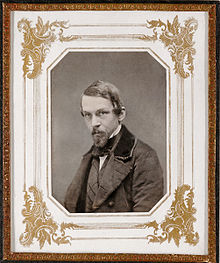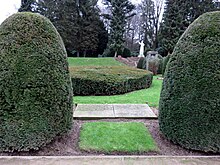Carl Ferdinand Stelzner



Carl Ferdinand Stelzner , born as Carl Ferdinand Rheinberger (* probably December 30 or 31, 1805 in Gömnitz ( Schleswig-Holstein ); † October 23, 1894 in Hamburg ) was a German portrait painter and daguerreotypist .
Life
Carl Ferdinand Stelzner was the illegitimate son of Dorothea Louise Rheinberger and Georg Wilhelm Limbach. He grew up in Flensburg as the adopted son of the portrait painter Carl Gottlieb Stelzner. In 1825 he wandered through Schleswig-Holstein and portrayed farmers and notables. In the late 1820s he traveled to Hamburg, Paris and Stockholm. As he stayed from 1831 to 1834 in Paris, he studied with Jean-Baptiste Isabey and Claude Marie Dubufe the miniature painting . In 1837 he settled in Hamburg. Stelzner was one of the first to recognize a new way of making money in the invention (disclosure of the patent) of the daguerreotype . He therefore traveled to Paris to familiarize himself with the new way of portraying.
From September 1842 Stelzner ran a daguerreotype studio with Hermann Biow in the Caffamacherreihe 32. At the end of March 1842 they ended their collaboration. The daguerreotypes of the great Hamburg fire in May 1842 were mistakenly ascribed to Stelzner for a long time. Biow's authorship has now been proven. The series is considered the first photographic report. On May 6, 1843, Stelzner portrayed the Hamburg Artists' Association from 1832 . It is considered the first open-air group picture in the history of photography. Stelzner settled at Jungfernstieg 11 in 1844 .
Like numerous other daguerreotypists, Stelzner went blind. The cause was the lack of knowledge of the proper handling of iodine and mercury . Around 1854 he gave up his activity and started looking for a manager. On May 15, 1858, he announced that the photographer H. Oscar Fielitz had taken over the management of his studio. Fielitz left the studio after just under a year to start his own business. Then the photographer Carl [Heinrich Christian] Siemsen took over the work. A little later, however, he too went into business for himself with a studio in the garden of Bergstrasse 16. On May 7, 1860, the outside photographer Georg Jacob Gattineau (* 1810, † 1888) received permission to stay in Hamburg as the manager of the Stelzner studio. He left Hamburg after a year and a half to settle in Würzburg. Since in 1862 the photographer H. Romberg reported Jungfernstieg 11 with the address, Stelzner stopped looking for a manager due to unsuccessfulness and presumably gave up his studio at the end of 1861 or sold it to him.
Stelzner was married twice. First marriage (1834) with his adoptive sister and miniature painter Anna Caroline Stelzner . The marriage was divorced by mutual agreement in 1848. In 1849 he married Anna Henriette Reiners. This marriage resulted in four children: Bruno, Alfred, Waldemar and Emil.
Stelzner became a citizen of Hamburg on October 9, 1840.
In the Ohlsdorf cemetery , in the area of the Althamburg Memorial Cemetery , near the main entrance to the cemetery, the graphic artist and painter, among others, is reminded of Carl Ferdinand Stelzner, whose name is on the left graphic artist's grave plate, on the double collective grave.
swell
literature
- Enno Kaufhold: Hermann Biow and Carl Ferdinand Stelzer in Hamburg. Legends, facts, descriptions, probabilities . In: Agfa Photo Historama (ed.), Bodo von Dewitz , Reinhard Matz : Silver and Salt . At the early days of photography in the German-speaking world, 1839–1860. Cologne: Edition Braus 1989, ISBN 3-925835-65-2 , pp. 352-403.
- Gabriele Betancourt-Nuñez: Stelzner, Carl Ferdinand . In: Hamburg biography . Volume 4. Wallstein, Göttingen 2008 ISBN 978-3-8353-0229-7 , pp. 328-329.
- Jan S. Kunstreich, Early Photographers in Schleswig-Holstein (= Small Schleswig-Holstein Books. Volume 36). Westholsteinische Verlagsanstalt Boyens, Heide 1985, ISBN 3-8042-0299-3
- Hans Joachim Schröder, portrait art between miniature and daguerreotype using the example of Carl Ferdinand Stelzner. In: Walter Hävernick (Museum for Hamburg History) (Ed.): Contributions to German folk and ancient history , Vol. 17, 1978, pp. 33–49, with panels 18–20.
- [Professor] Wilhelm Weimar , Die Daguerreotype in Hamburg , (1st supplement to the yearbook of the Hamburg Scientific Institutions, XXXII, 1914,) Verlag Otto Meissner, Hamburg, 1915 (with images in the back of the book), p. 26ff., ( Digitized )
- Rolf Sachsse, Stelzner, Carl Ferdinand (1805–1894) . In: John Hannavy, Encyclopedia of Nineteenth-Century Photography. New York: Routledge 2007, p. 1337.
Web links
- painting
- Portrait of Anna Caroline Stelzner (gouache on ivory). Museumsberg Flensburg , 1834, accessed on March 31, 2017 .
- Daguerreotypes:
- Illustrations. In: Photographic Collection. Museum für Kunst und Gewerbe Hamburg , accessed on March 31, 2017 .
- Illustrations. In: Photographic Collection, Museum Ludwig . Rheinisches Bildarchiv Cologne , accessed on March 31, 2017 .
- Illustrations. In: Collections. National Gallery of Canada , accessed March 31, 2017 .
- Illustrations. In: Photographic Collection. J. Paul Getty Museum . Retrieved March 31, 2017 .
Remarks
- ^ Matthias Gretzschel: The first photo of Hamburg . In: Hamburger Abendblatt . December 24, 2002.
- ↑ The Museum for Art and Commerce Hamburg . Volume 1. From the beginning to 1945 . Hamburg 2004, ISBN 3-923859-60-0 , p. 215.
- ↑ a b Bodo von Dewitz , Fritz Kempe : Daguerreotypien, Ambrotypien und Bilder Other Procedures , Museum für Kunst und Gewerbe, 1983, p. 267.
- ↑ William Horn: As Comganon: . In: Photographic Journal . tape 7 . Otto Spamer, Leipzig 1857, p. 40 ( slub-dresden.de ). With this advertisement Fielitz had offered his services. It is conceivable that the Hamburg photographer Heinrich Friedrich Plate (* 1824, † 1895) initially reacted to this advertisement in March 1857 and then worked for Stelzner (further source: Wilhelm Weimar: Die Daguerreotype in Hamburg , pp. 31–32) .
- ^ H. Oscar Fielitz died only a few weeks later at the end of May 1859.
- ^ A b Fritz Kempe: Daguerreotype in Germany , Heering Verlag, Seebruck / Chiemsee, 1979, ISBN 3-7763-5190-X , pp. 125–128.
- ↑ Business directory of the Hamburg address books.
- ^ List of those who became citizens . In: Hamburger Nachrichten of October 13, 1840, page 4
| personal data | |
|---|---|
| SURNAME | Stelzner, Carl Ferdinand |
| ALTERNATIVE NAMES | Rheinberger, Carl Ferdinand (maiden name) |
| BRIEF DESCRIPTION | German portrait painter and daguerreotypist |
| DATE OF BIRTH | uncertain: December 30, 1805 or December 31, 1805 |
| PLACE OF BIRTH | Gömnitz , Schleswig-Holstein |
| DATE OF DEATH | October 23, 1894 |
| Place of death | Hamburg |
